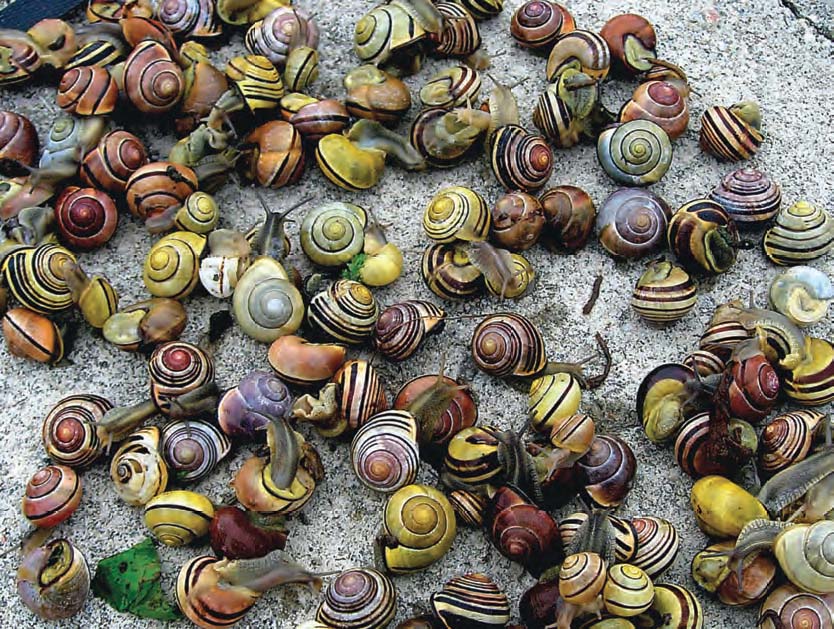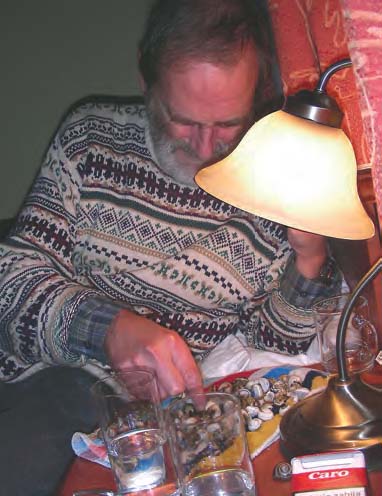In the July 2006 number of Mollusc World I wrote about the absence of clausiliid snails in the otherwise very rich woods within the Sheffield city boundaries. In that month, I had the opportunity to survey woods in the Moss Valley SSSI (at SK4180), right on the edge of the city, and effectively in a rural setting. I visited it again in November. In both cases, I was working with the Moss Valley Wildlife Group and the Sorby NHS.
Although it is surrounded by farmland, the Moss Valley is a typical Coal Measures stream valley, with steep sides and a flat, rather waterlogged base. Like those nearer the city centre, the woods there are full of the remains of earlier industry: old dams, millraces, engine houses, etc. While the sides are covered in planted beech and conifers, with some oak, the valley bottom is much richer, with alder, ash, sycamore, Norway Maple, willows and wych elm, and under these are lots of nettles, great willowherb, dog’s mercury and yellow archangel.
I made two samples in the valley bottom, in similar woodland, about 300m apart; One was made in July and the other in November. In both cases, I searched for about an hour within an area of less than 1000 square metres, and collected and sieved lots of litter. The weather in July was hot and dry, though it had rained earlier in the month. The visit in November was mainly to find more slugs, which I was convinced had not been adequately sampled, but I could not resist making another snail sample too! Everything was a lot wetter.
The table shows the results of each visit. These woods are remarkably rich. With 38 species recorded for the two sites combined, and 37 for the July site (with some slugs added in November), they are richer, by a small margin, than anything I have found elsewhere in the city. What is notable is that both Clausilia bidentata and Merdigera obscura occur here, well to the south and west of major industrial pollution. C. bidentata is very common, and even in November I found many active or resting on tree trunks.
I do not know of any other woods off limestone or chalk that beat this for number of species. Nevertheless, Peter Tattersfield (Journal of Conchology, 33: 355-374. 1990.) recorded 44 species among 17 rather similar woods on Millstone Grit, but a maximum of 35 from a single wood. There are several species in his list that were not found in Moss Valley, notably Azeca goodalli, Euconulus alderi (found in a small open marsh in the valley, but not in the woods), Leiostyla anglica, Zenobiella subrufescens and Zonitoides nitidus. Some of these can be very local in their occurrence, and could perhaps be found at some time in the future. One of the many bees in my bonnet is the problem of knowing how complete, or representative, a sample is; while you can never be absolutely certain that you have found everything, there are a few checks that can be made (there are more details in Cameron, R A D and Pokryszko, B M. 2005. Estimating the species richness and composition of land mollusc communities: problems, consequences and practical advice. Journal of Conchology, 38: 529-548.)
In this case, I am pretty confident that the snail fauna for this part and kind of the woods is complete (maybe one extra species would not surprise me). No species are represented by single specimens; the larger second sample revealed no species not found in the first; The log frequency against rank diagram shows a dramatic descent at the rare end. The oddity is Vertigo substriata that was found in the first, smaller, sample but not in the second. Maybe it has a very patchy distribution, and the first site was marginally less disturbed.
The good news, from my point of view, is that the first sample gave a good record of the snail fauna. For the second, I took vast quantities of litter, and the processing took ages. Had I removed, identified and counted all juveniles it would have taken even longer. In this kind of wood, a sample of 500-1000 shells seems to be adequate.
2. Cepaea nemoralis in Sheffield.

 In the July piece, I mentioned that lots of species, including C. nemoralis, seem to be returning to the city since it has become less polluted. This summer and autumn, I have started to sample it systematically across the city to see how populations vary in the spectacular colour and banding polymorphism in the shell. This is part of a joint project with my Polish colleagues Beata Pokryszko and Margorzata Olgo, who are doing the same in two cities there (Wroclaw and Gdansk). So far, I have only covered the southwest quarter of the city, but it is apparent that C. nemoralis is very common, especially in long-derelict sites and in woods (Sheffield claims to be one of the greenest cities in the country). Judging by the number of “anvils” in the woods, song thrushes must be pretty common too. Nevertheless, there are districts where it does not occur, even though the garden snail Cornu aspersum does, and I suspect that the colonisation is still going on. There are also patches where it is replaced by Cepaea hortensis, mostly on higher ground to the west.
In the July piece, I mentioned that lots of species, including C. nemoralis, seem to be returning to the city since it has become less polluted. This summer and autumn, I have started to sample it systematically across the city to see how populations vary in the spectacular colour and banding polymorphism in the shell. This is part of a joint project with my Polish colleagues Beata Pokryszko and Margorzata Olgo, who are doing the same in two cities there (Wroclaw and Gdansk). So far, I have only covered the southwest quarter of the city, but it is apparent that C. nemoralis is very common, especially in long-derelict sites and in woods (Sheffield claims to be one of the greenest cities in the country). Judging by the number of “anvils” in the woods, song thrushes must be pretty common too. Nevertheless, there are districts where it does not occur, even though the garden snail Cornu aspersum does, and I suspect that the colonisation is still going on. There are also patches where it is replaced by Cepaea hortensis, mostly on higher ground to the west.
The populations found so far differ from each other rather a lot, certainly far more than an equivalent number of samples from Wroclaw, suggesting different patterns of colonisation and population sizes; we will try to relate this to the cities’ histories in due course. Among the other species seen is the invasive Hygromia cinctella, which seems to have worked its way along one of the many valleys descending to the city centre.
Over the next few years the Open University will be running a public “Megalab” on variation in Cepaea. My information will go into the scheme, and I would be happy to hold workshops for any group that wants to participate. I think the public part will start in 2008/9.
Photo credits:
1. Cepea banding from samples from Gdansk, Poland. R. Cameron
2. Robert Cameron sorting Cepea spp in Poland. B. Pokrysko
Table 1 Numbers of snails, and occurrences of slugs in the Moss
| Snails | |||
| Species | Wood 1 | Wood 2 | Wood 3 |
| Carychium minimum | 6 | 27 | 33 |
| Carychium tridentatum | 113 | 201 | 314 |
| Succinea putris | 17 | 45 | 62 |
| Cochlicopa lubrica | 36 | 78 | 114 |
| Cochlicopa lubricella | 3 | 21 | 24 |
| Columella edentula | 17 | 38 | 55 |
| Vertigo substriata | 3 | 0 | 3 |
| Lauria cylindracea | 41 | 336 | 377 |
| Acanthinula aculeata | 47 | 83 | 130 |
| Merdigera obscura | 9 | 8 | 17 |
| Punctum pygmaeum | 10 | 38 | 48 |
| Discus rotundatus | 182 | 208 | 390 |
| Vitrina pellucida | 11 | 19 | 30 |
| Vitrea crystallina | 16 | 51 | 67 |
| Vitrea contracta | 16 | 27 | 43 |
| Nesovitrea hammonis | 5 | 17 | 22 |
| Aegopinella pura | 57 | 123 | 180 |
| Aegopinella nitidula | 18 | 9 | 27 |
| Oxychilus cellarius | 23 | 29 | 52 |
| Oxychilus alliarius | 19 | 59 | 78 |
| Zonitoides excavatus | 20 | 18 | 38 |
| Euconulus fulvus | 9 | 61 | 70 |
| Clausilia bidentata | 32 | 145 | 177 |
| Trochulus hispidus | 30 | 40 | 70 |
| Cepaea nemoralis | 4 | 6 | 10 |
| Cepaea hortensis | 6 | 8 | 14 |
| Total individuals | 750 | 1769 | 2519 |
| Total species | 26 | 25 | 26 |
| Slugs | |||
| Arion rufus agg. | X | X | X |
| Arion flagellus | X | X | |
| Arion subfuscus | X | X | X |
| Arion silvaticus | X | X | X |
| Arion fasciatus | X | X | |
| Arion distinctus | X | X | X |
| Tandonia budapestensis | X | X | |
| Deroceras reticulatum | X | X | X |
| Deroceras laeve | X | X | |
| Limax cinereoniger | X | X | |
| Limax maximus | X | X | X |
| Lehmannia marginata | X | X | X |
| Slug species | 11 | 8 | 12 |
| Overall species | 37 | 33 | 38 |
